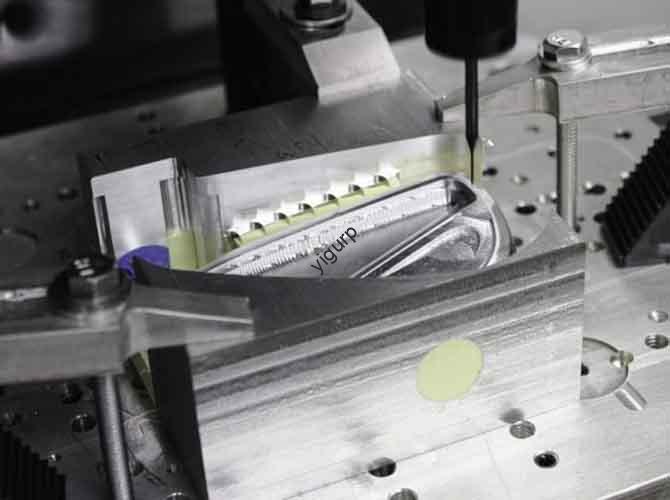When evaluating whether aluminum alloy prototypes are “cher,” the answer depends on multiple factors—including material costs, processing methods, and project requirements. This article breaks down the key cost drivers, compares aluminum alloy prototypes to alternatives, and helps you determine if they fit your budget and needs.
1. Why Do Aluminum Alloy Prototypes Cost More Than Plastic Ones? A Direct Comparison
The most common reference point for prototype costs is 3D printed plastic prototypes (Par exemple, PLA, Abs). Below is a side-by-side comparison to highlight the cost differences and reasons:
| Facteur | Aluminum Alloy Prototypes | 3D Printed Plastic Prototypes | Cost Gap Reason |
| Coût des matières premières | Plus haut (Par exemple, 6061/6063 alliage en aluminium: \(2- )5 par kg) | Inférieur (Par exemple, PLA: \(0.5- )1 par kg; Abs: \(1- )2 par kg) | Aluminum alloys have higher raw material purity and mechanical property requirements. |
| Processing Waste | 15–30% waste (from CNC cutting/engraving) | <5% déchets (fabrication additive) | Subtractive processes like CNC remove excess material, increasing waste. |
| Coût de l'équipement | Haut (\(100k– )500k for CNC machines) | Inférieur (\(1k– )50k for FDM/FFF 3D printers) | CNC machines require high precision and automation, driving up depreciation costs. |
| Single-Piece Price | \(200- )2,000 (petit lot, 1–10 pièces) | \(20- )200 (same batch size) | Aluminum prototypes need more labor (programmation, soudage) et traitement de surface. |
2. Key Factors That Drive Aluminum Alloy Prototype Costs
Not all aluminum alloy prototypes cost the same—their price varies significantly based on 6 facteurs fondamentaux. Understanding these helps you optimize costs:
2.1 Méthode de traitement
Different processing techniques directly impact labor and time costs:
- Usinage de précision CNC: The most common method for aluminum prototypes. It’s ideal for complex structures (Par exemple, trous filetés, hollow chambers) but requires 2–10 hours per piece (contre. 1–3 hours for plastic 3D printing). Costs increase with machining time.
- Welding/Assembly: Si le prototype a plusieurs parties (Par exemple, a 2-piece aluminum housing), welding adds \(50- )200 per joint, plus quality inspection time.
- Traitement de surface: Almost all aluminum prototypes need treatments to improve durability and appearance—each adds to the cost:
- Sable: \(30- )80 par pièce
- Anodisation (clear/colored): \(50- )150 par pièce
- Électroplaste (chrome/nickel): \(80- )250 par pièce
2.2 Precision and Complexity
Higher precision or complexity = higher costs. Par exemple:
- A basic aluminum bracket with ±0.1mm tolerance costs ~$200.
- A medical device component with ±0.05mm tolerance and internal hollow channels costs ~\(800- )1,500.
Pourquoi? Complex designs require:
- More detailed CNC programming (2–3x longer than simple designs).
- Multiple machining setups (Par exemple, flipping the part for 5-axis CNC).
- Post-traitement (Par exemple, deburring tiny gaps).
2.3 Quantité: Small Batches Hurt, Large Batches Don’t Help Much
Contrairement aux prototypes en plastique (where injection molding reduces costs for large batches), aluminum prototypes have limited economies of scale:
| Taille de lot | Aluminum Alloy Prototype Cost per Piece | Plastic Prototype Cost per Piece (Moulage par injection) |
| 1–10 pièces | \(200- )2,000 | \(20- )200 (3D imprimé) |
| 100–500 pieces | \(150- )1,200 | \(5- )30 (injection molded) |
| 1,000+ pièces | \(100- )800 | \(2- )15 (injection molded) |
Pourquoi? Aluminum prototypes rely on CNC machining (no mold sharing), while plastic injection molding spreads mold costs across thousands of parts.
3. When Are Aluminum Alloy Prototypes Worth the Cost?
Aluminum prototypes are “cher” only if they’re used for the wrong scenarios. Ils sont rentable quand:
- You need to test performance mécanique: Aluminum has higher strength (6061 alliage: 276 Force de traction MPA) et résistance à la chaleur (point de fusion: 660° C) than plastic—critical for prototypes like engine parts or industrial tools.
- You require a premium texture: Anodized aluminum has a metallic finish that plastic can’t replicate (Par exemple, high-end smartphone casings, audio equipment).
- You need to verify metal component assembly: If the final product uses aluminum, testing with an aluminum prototype avoids fit issues (Par exemple, 螺丝 holes alignment, part mating).
4. Yigu Technology’s Perspective on Aluminum Alloy Prototype Costs
À la technologie Yigu, nous croyons “expense” is relative to value. Aluminum alloy prototypes are not cheap, but they deliver irreplaceable benefits for high-stakes projects: they prevent costly design flaws in mass production (Par exemple, a misaligned aluminum bracket could ruin an entire device line). We often advise clients to prioritize their core needs: if functional testing (Par exemple, chargé de chargement) or aesthetic display is critical, aluminum is a wise investment. For budget-limited, low-stress scenarios (Par exemple, early-stage appearance models), we recommend starting with 3D printed plastic prototypes and upgrading to aluminum only when necessary. Our team also optimizes designs—simplifying curved surfaces or reducing thin walls—to cut CNC machining time by 15–25%, équilibre entre coût et performance.
5. FAQ: Common Questions About Aluminum Alloy Prototype Costs
T1: Can I reduce aluminum alloy prototype costs without sacrificing quality?
Oui. Optimize your design: remove unnecessary complex surfaces (Par exemple, non-functional arcs), use standard aluminum grades (6061 est moins cher que 7075), and limit surface treatments to only what’s needed (Par exemple, sandblasting instead of electroplating for internal parts).
T2: Is metal 3D printing a cheaper alternative to CNC-machined aluminum prototypes?
Non. Impression en métal 3D (Par exemple, SLM for aluminum) est plus cher (\(500- )3,000 par pièce) and less mature. It’s only used for ultra-complex designs (Par exemple, structures en treillis) that CNC can’t produce. Pour la plupart des projets, CNC-machined aluminum is cheaper and more reliable.
T3: When should I choose injection-molded aluminum over aluminum prototypes?
Injection-molded aluminum (moulage) is for production de masse (10,000+ pièces). Le coût du moule (\(50k– )200k) is high, so it’s not feasible for prototypes. Use aluminum prototypes to verify your design first, then switch to die casting for large batches.
